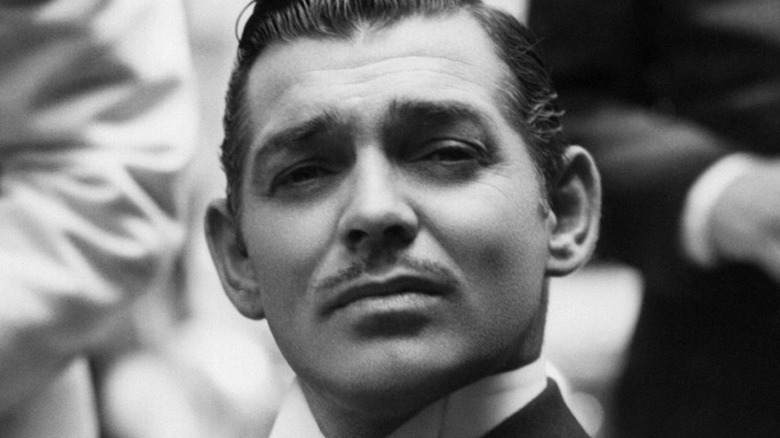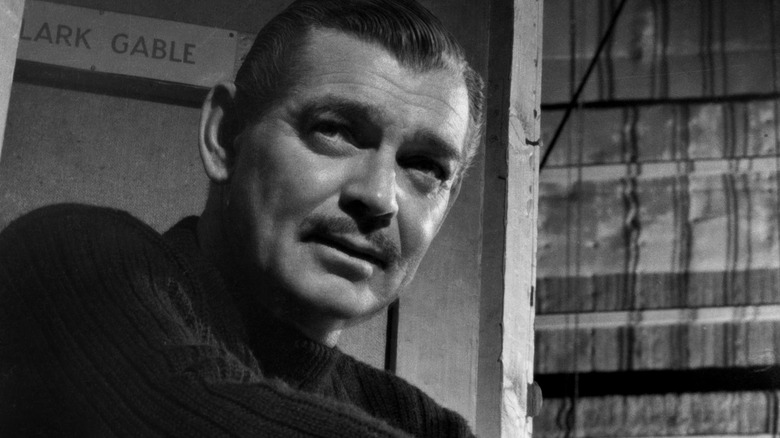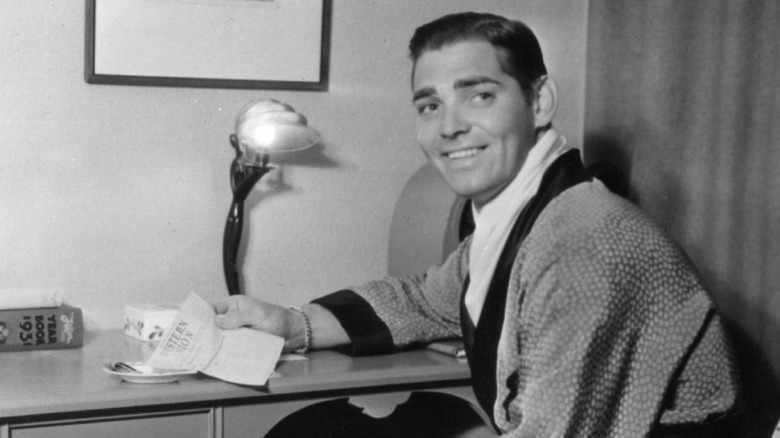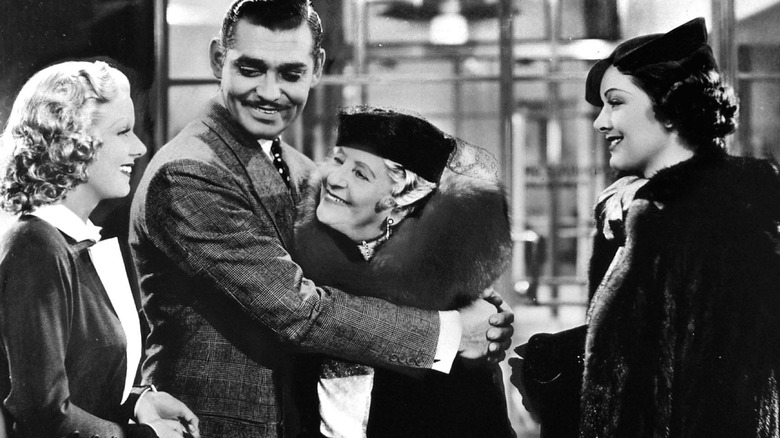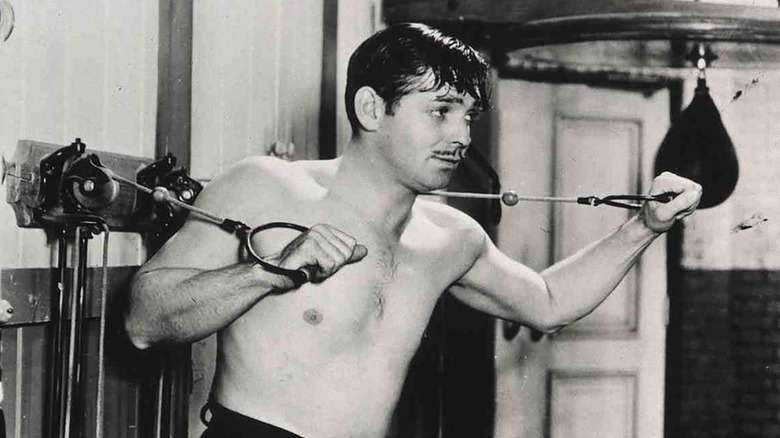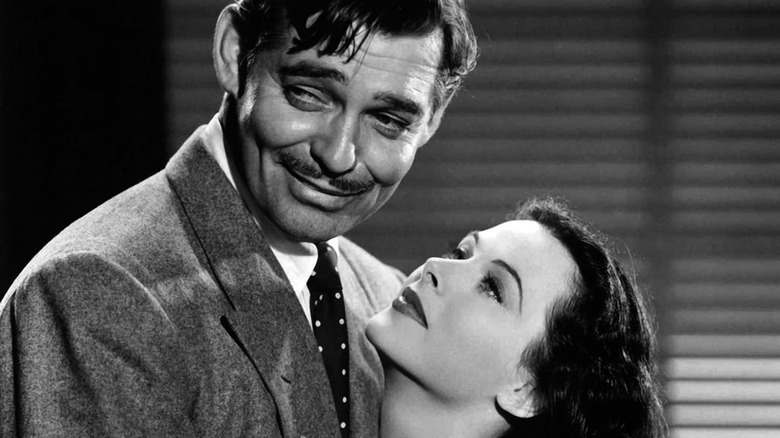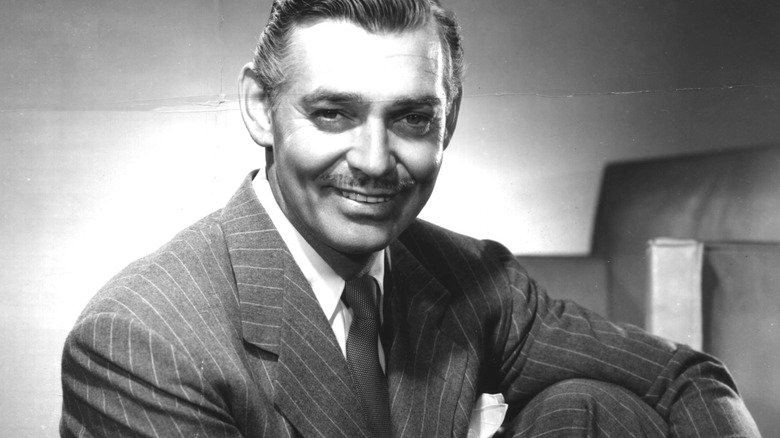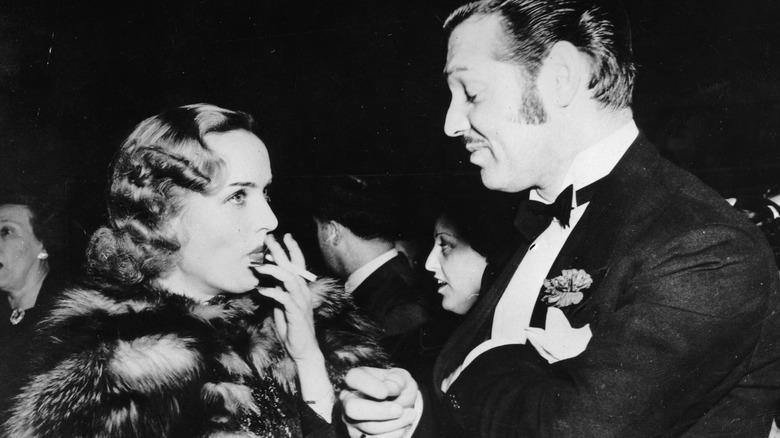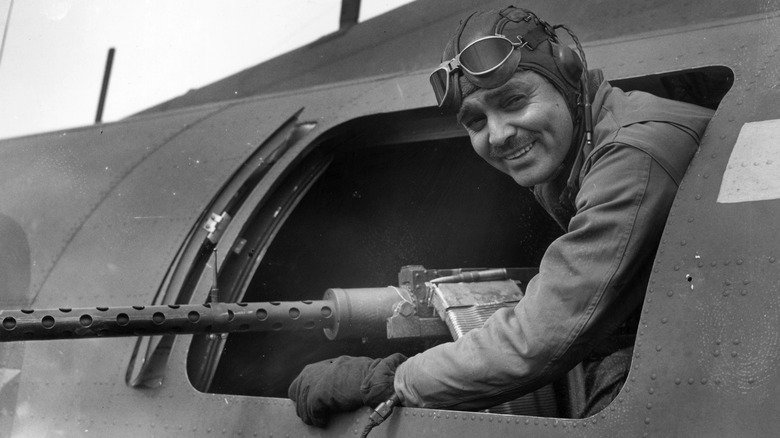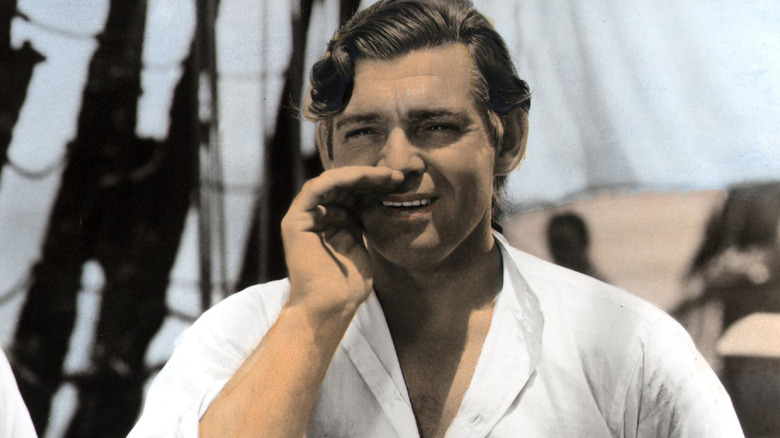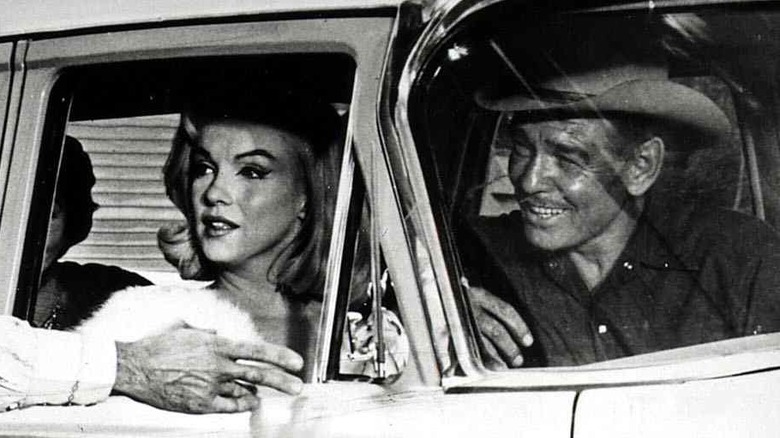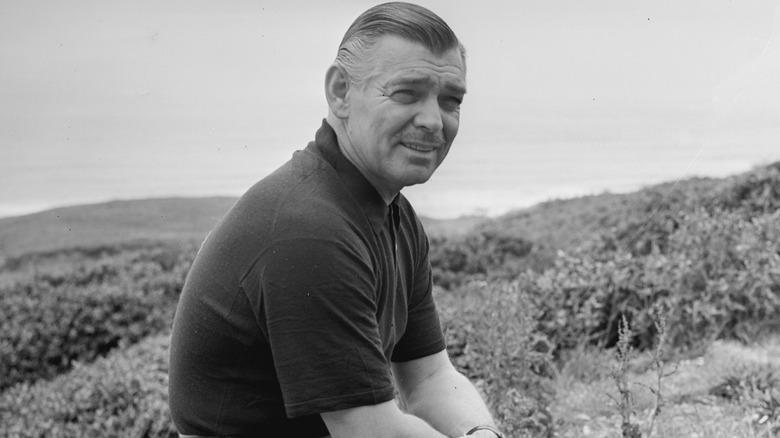The Untold Truth Of Clark Gable
Hollywood's Golden Age began after the silent movie era, with the incorporation of sound in filmmaking. According to History, there were five studios that dominated during this time: Warner Brothers, RKO, Fox, MGM, and Paramount. As these production companies began churning out flicks across all genres, be it horror films, Westerns, or even romantic dramas, the rise of studio movie stars and the concept of celebrities were at an all-time high, too.
Along with his leading-man contemporaries, such as Cary Grant and Humphrey Bogart, Clark Gable oozed masculinity and a practically unmatched swagger. At the height of his popularity (which lasted almost an incredible three decades), Gable was dubbed the "King of Hollywood," with his gruff demeanor winning the hearts of female fans while earning the respect of his male audience, too (via TCM). Today, he's probably best remembered for playing the devilish Rhett Butler in 1939's "Gone with the Wind" (and for delivering what's perhaps the most quotable line in film history), yet his rise to the ranks of Hollywood royalty wasn't as suave as his on-camera persona.
After suffering a devastating trauma later in his life, "The Misfits" lead's star power slowly declined, yet, as TCM notes, "there was still no substitute for Clark Gable." As Hollywood's Golden Age came to a close in the early '60s with the rise of television (and Gable's death in 1960), perhaps that substitute never even appeared. This is the untold truth of Clark Gable.
Clark Gable had a modest upbringing
Clark Gable truly came from humble beginnings. Per Biography, the future screen star was born on February 1, 1901, in Cadiz, Ohio, to his father, William Henry Gable, an oil-driller and farmer, and his mother, Adeline, who sadly suffered from severe physical health problems. According to the actor's biography, "Clark Gable," Addie, as she was known, had some form of sickness for the majority of her life, and when she became pregnant with Clark, doctors advised her that giving birth would also kill her.
Nevertheless, Addie proceeded to have her son, giving birth in their duplex clapboard house, and paying an expensive $10 at the time for a doctor to come while also receiving "volunteer help" from their neighbor downstairs. While it's not exactly clear what sort of sickness plagued Clark's mother, the doctor who delivered her son believed that she was suffering from "a progressive brain tumor," with "her behavior [becoming] increasingly psychotic." Sadly, she only had a mere 10 months with her baby boy before her untimely death at age 31 (via "Clark Gable").
After Addie's passing, Clark was shipped off to his aunt and uncle from his mother's side while his father looked for a new home (and bride). While it's believed he adjusted to his new life on a farm with ease, many have asserted that the actor spent his adult years "looking for a substitute mother." When William remarried in 1903, the future star finally moved back with his father and new stepmother.
His desire to act was sparked when he was a teenager
As a teenager, Clark Gable was involved in technical jobs, working at a tire factory in Ohio after he dropped out of school at age 16. According to Far Out magazine, the job made sense; after all, the future star enjoyed fixing cars in his youth, along with other "mechanical activities." It's not to say Gable was only a tradesman, however, as he blended his love for technical skills with the intellectual, too, "reciting Shakespeare" for friends and reading literature. At 13, he was his town's youngest band member — an affinity for music that was bolstered by his stepmother's encouragement.
Surprisingly, Gable's most influential moment came while he was employed at the tire factory. Per Far Out, the teen just so happened to see a production of "The Bird of Paradise" by Richard Walton Tully and loved it so much that he suddenly knew what his long-term profession would be.
Interestingly enough, although the Old Hollywood legend was the winner of one Academy Award (for his role in "It Happened One Night") and a nominee of two others, he remained humble about his talents. As The New York Times wrote the day after his death on November 17, 1960, Gable once professed he didn't believe he was an exceptional actor. "I can't emote worth a damn," the star declared. "When I die, they'll put on my tombstone, 'He was lucky – and he knew it.'"
Did Clark Gable use his first two wives to position himself in Hollywood?
Clark Gable's rise to fame was an interesting one — mainly because of the connections he had. As detailed by OZY, in 1924, 23-year-old Gable moved to Hollywood to pursue his dreams. Described as "lanky and somewhat effeminate," his resume didn't help much, either, having only acted in a few Oregon-based theatrical productions.
Thankfully, Gable had his biggest fan by his side: his wife, Josephine Dillon — who was 18 years his senior. According to Far Out magazine, Dillon met her future beau in Oregon, where she was working as a theater manager. In a sort of "My Fair Lady" situation (or "My Fair Gentleman," in this case), Dillon used the money she had to fix his unflattering teeth and hairstyle, while also lowering Gable's speaking register and "[training] him in body language." When Gable was finally ready, the pair headed for Los Angeles.
Dillon, who acted as her husband's manager, managed to land Gable a few bit parts while also using her connections to snag the actor a role in "Machinal" on Broadway in 1928 (via Far Out). Gable's star only rose on Broadway, albeit it came at the cost of his marriage. Per OZY, he left Dillon for the incredibly wealthy Ria Langham — who became his second wife in 1931 and helped Gable "get established on Broadway." Gable's star power only rose at this point, thanks to Langham's "high society" connections in New York (via Den of Geek).
He wasn't initially considered Hollywood material
What did Cary Grant, Gregory Peck, and Errol Flynn all have in common? These leading men of Hollywood's Golden Age were all considered conventionally handsome, with their rugged good looks and sartorial elegance. Clark Gable, on the other hand, was a manufactured Tinseltown star, only changing his appearance at the behest of his first two wives. "Clark Gable's first two wives were both older women and were pretty instrumental in changing the type of man that he was both physically and the way that he comported himself," explained Old Hollywood biographer Anne Helen Petersen to OZY.
Try as the actor's two wives might, not everyone fell for Gable's facade. At least, not initially. According to OZY, MGM studio head Louis B. Mayer once told the budding star that he was "too elephant-eared and unattractive" to reign as a silver screen icon. As such, throughout the early 1930s, Gable was stuck playing minor roles such as thugs or villains — yet surprisingly, his female fans responded with rave reviews.
What happened next was crucial for Gable's success: MGM realized the profitability of this bit-playing star and began to "groom" him to become the leading man he would forever be remembered as by styling his hair and eyebrows, giving him dentures, and forcing him to go to the gym. "Gable was a complete studio creation," explained biographer E.J. Fleming to OZY, noting that what audiences saw on camera "was the antithesis" of who he truly was.
He wasn't exactly a gentleman
Clark Gable, the "King of Hollywood," dominated cameras with his rugged (albeit manufactured) good looks and nonchalant persona. As Hollywood biographer Anne Helen Petersen told OZY, it was his "swarthy, unshaven masculinity" that drew in the most lust from his female devotees and was even often copied by male moviegoers. While all this is fantastic for the characters he played, what was he like when the cameras stopped rolling?
According to The Guardian, Gable was a notorious womanizer. Perhaps one of the most shocking stories about Gable was the one shared by fellow Old Hollywood icon Loretta Young — and only in her memoir after her death. According to Buzzfeed News, Gable and Young crossed paths as co-stars on the 1935 flick, "Call of the Wild," where they began flirting instantly. Once production wrapped on location and the cast and crew boarded a train en route back to Hollywood, Young recalled Gable entering her compartment, where he allegedly raped her, resulting in a pregnancy.
At the time, he was married to Ria Langham, and Young didn't tell a soul what had happened until years after the incident, hiding her pregnancy for as long as she could. She eventually gave birth to a girl, Judy, and shipped her off to be raised by nuns until she cleverly took her back two years later and disguised the entire ordeal as a mere adoption (via Los Angeles Times).
If you or anyone you know has been a victim of sexual assault, help is available. Visit the Rape, Abuse & Incest National Network website or contact RAINN's National Helpline at 1-800-656-HOPE (4673).
He was incredibly obsessed with cleanliness
Clark Gable was the ideal sort of masculine hunk that the Golden Age of Hollywood required out of its leading males — but don't associate any kind of rugged, musky scent with the "Call of the Wild" star. As detailed in "Clark Gable: A Biography," while the future actor was still a young boy, his stepmother, Jeannie, instilled a love of cleanliness in him, dressing him "in the finest clothes she could buy" and making sure he was "immaculately groomed." According to the biography, one female fan once observed, "He was so clean you could eat off him."
This acute obsession with hygiene only carried on into Gable's adult life — something that screenwriter John Mahin observed when he served in the army with the actor during World War II. Talking about Gable's "cleanliness fetish" in "Clark Gable: A Biography," Mahin recalled, "He shaved his chest and armpits," noting that Gable "[couldn't] stand hair." He was also repulsed at the thought of Mahin taking a bath, opting instead for showers so he wouldn't sit in dirty bathwater.
Interestingly enough, although Gable was hypersensitive to hygiene, his co-stars didn't enjoy kissing him. According to The Courier-Mail, the actor was known for his bad breath due to his dentures, and Gable's "Gone with the Wind" co-star, Vivian Leigh, "[complained] about filming their more passionate moments in between scenes."
Did he have a death wish after losing the 'love of his life?'
Clark Gable was married five times throughout his life, but no other woman truly captured his heart like that of his third wife, Carole Lombard, who was without a doubt seen as the "love of his life," per Biography.
According to Den of Geek, Gable and Lombard met in 1932 on the set of their movie, "No Man of Her Own." Lombard, a married woman at the time, definitely saw sparks fly between herself and her co-star, yet no moves were made — yet. By 1936, the pair ran into one another again and promptly started dating before eloping three years later. Sadly, their marital bliss was cut short with World War II. In January 1942, the Treasury Department for the Victory Committee decided to begin "[launching] Indiana's participation in the national campaign of selling war bonds." Lombard, who was born in Indiana, was sent to Indianapolis to help with the campaign. When it came time to head home, the Treasury Department didn't allow for commercial flying, yet the actor decided to take a plane back to Burbank, California. Tragically, the plane never arrived.
By August 1942, a heartbroken Gable joined the Army air force, telling his former publicist's widow, "I'm going in, and I don't expect to come back." Per Den of Geek, ever since then, there has been "speculation" over whether or not the star "actually wanted to die in World War II."
Adolf Hitler had his eyes peeled for Clark Gable
After the death of the "love of his life" Carole Lombard in 1942, Clark Gable signed up to join the Army air force during World War II with guns blazing (via Den of Geek). "Carole Lombard, his wife, wanted him to go fight and she's killed," explained Robert Matzen, author of "Mission: Jimmy Stewart and the Fight for Europe," to the outlet. "So he then decides, 'Alright, I'll go fight and hopefully I'll be killed too.'"
While Gable "wanted to die in a plane crash," there was another fear looming on the horizon: Adolf Hitler. As revealed by Den of Geek, Hitler was a huge fan of Gable's and even considered him "his favorite American actor." It's alleged that the dictator had bootlegged a theater copy of "Gone with the Wind" before it was even released in the U.K. As such, Hitler considered the star "one of the most prized 'war criminals' in the Allied Forces" and even offered up some generous incentive for any soldier that could deliver him Gable — still alive.
Per Den of Geek, Gable was acutely aware of this terrifying reality, and once even declared to a friend, "If Hitler catches me, the sonofab**** will put me in a cage like a gorilla and send me on a tour of Germany," adding that if his plane was to ever get hit by German soldiers, he wouldn't even try to survive.
Was Clark Gable responsible for a dip in underwear sales?
There's no doubt that as one of Tinseltown's leading men, Clark Gable had a lot of influence. As revealed by OZY, once he became known as the "King of Hollywood," his male fans started "emulating his brash, macho style" — yet it wasn't just the A-lister's on-screen personality that they copied.
In 1934, Gable released the Frank Capra-directed "It Happened One Night," which earned the actor an Academy Award for Best Actor in a Leading Role. "'It Happened One Night' is the real Gable. He was never able to play that kind of character except in that one film," declared Capra once, per Far Out magazine. Sure enough, "the real Gable" did shine through, right down to his costuming choices. The star's character, Peter Warne, didn't wear an undershirt in the flick — something that wasn't exactly the norm in the '30s. "That was just the way I lived," mused Gable in 1957 (via "Clark Gable: Biography, Filmography, Bibliography"), noting that he didn't wear undershirts since he was a teen. "They made me feel hemmed in and smothered."
According to Far Out, Gable's decision to appear undershirt-less in "It Happened One Night" allegedly shook the men's underwear industry after its release and saw sales plummet, with his star appeal influencing his biggest fans. However, perhaps take this story with a slight grain of salt, as fact-checking website, Snopes, has listed this tale as "undetermined."
The Marilyn Monroe connection
Clark Gable and Marilyn Monroe were easily some of the biggest stars during the Golden Age of Hollywood, both international icons in their own right. Interestingly enough, they only starred in one movie together, 1961's "The Misfits," which proved to be the final, finished project for both stars before their untimely deaths. Sadly, according to Biography, Gable never even had a chance to see "The Misfits" on the big screen, having suffered a fatal heart attack two days after filming had wrapped up. Monroe, on the other hand, began shooting "Something's Got to Give" alongside Dean Martin in 1962, yet the project was ultimately shelved after the star died of a drug overdose that same year.
While many consider Gable's role in "The Misfits" to be one of his greatest (via Biography), it turns out that shooting the Western was anything but easy. According to Today, Monroe was going through a breakup with the movie's screenwriter, Arthur Miller, while also fighting an alcohol addiction and various "psychological problems." As such, filming would be delayed on days that she appeared late or didn't show up altogether.
Sadly, after Gable's death, Monroe's own condition only spiraled. Per "Marilyn Monroe: Her Films, Her Life," the actor felt immense guilt for how she acted while on set, believing she may have contributed to her co-star's demise. Kay Gable, Clark's widow, extended an olive branch to Monroe after the birth of their son, John Clark, and invited the blonde star to his christening, which she attended.
If you or anyone you know is struggling with addiction issues, help is available. Visit the Substance Abuse and Mental Health Services Administration website or contact SAMHSA's National Helpline at 1-800-662-HELP (4357).
His death at age 59 came as a surprise
By the time the early 1960s came around, Clark Gable had starred in an impressive 82 films, having begun his acting journey in the early 1920s. According to The New York Times, he was the undisputed "King of Hollywood" for over two decades and had such a powerful box office draw that some movie theaters would merely put on their marquees: "This week: Clark Gable."
In November 1960, a tragedy occurred: Gable was hospitalized for a heart attack. According to the Los Angeles Times, the star was rushed to the hospital, where doctors believed he would make it out alive, noting he was "doing fine." Sadly, the "Mogambo" star died on November 16th, 10 days after being admitted to the Hollywood Presbyterian Hospital.
Gable remained humble about his success until the very end. The New York Times revealed that even when he was bringing in $7,500 a week, he had reminders littered throughout his dressing rooms citing his lower-class upbringing. Across some of these reminders, the A-lister wrote, "Just to remind you, Gable."
